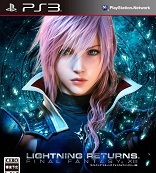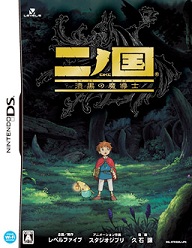Wind of Nostalgia (Nostalgio no Kaze)
Nintendo DS
Reviewed: 07/27/2009
 Wind of Nostalgio is not Skies of Arcadia. Let’s get that out of
Wind of Nostalgio is not Skies of Arcadia. Let’s get that out of
the way first. It is similar to Skies of Arcadia in the sense that they deal
with the same themes, like airships and exploration, and are both RPGs, and if
that’s enough of an association for you, wonderful. Keep thinking it’s like
Skies of Arcadia. But remember that it’s not Skies of Arcadia, nor is it trying
to be. What it is trying to be is a traditional RPG, which it enormously
succeeds at. In fact, it could become one of the definitive examples of a good,
generic RPG on the DS, in that it is good in almost every way, bad in almost no
ways, and great in a select few ways.
Nostalgio takes place on the world map we all know and love: Earth. The
player starts out in London, and soon acquire an airship, enabling him to
explore select pieces of Europe and Africa. As the story progresses and the
airship’s Flight Core improves, it gains the ability to fly higher and higher,
over obstacles such as mountains and clouds. The world contains such culturally
diverse major cities as Cairo, St. Petersburg, New York, and Rio de Janeiro, and
dungeons such as the Egyptian Pyramids, the Amazon Jungle, and a secret
mechanical base inside Mt. Fuji. Exploring the world is fun, even when a few
liberties are taken with the settings for the sake of the story. There are a few
obvious tips of the hat to the Indiana Jones franchise, as well. Travelling the
world can be dangerous, though, as airship battles on the world map are always a
possibility.
Battles, both the character and airship varities, play out as simple
turn-based affairs. The turn order is displayed on the left of the bottom
screen, and as an option is highlighted by the player, the modified turn order
is shown. Each character can Attack, use Skills, Defend, use an Item, or attempt
to Escape, with slightly different weight being placed on each option. Defending
causes that character’s turn to come up fastest, whereas Skills can delay the
next turn by a significant amount of time. This adds some strategy, as players
have to decide whether to go all out with their skills and then be rendered
vulnerable as foes get several turns in a row, or to take it slow and safe with
regular attacks. Skills are usually the most powerful option, but not always,
since some enemies have high resistance to magic or elements. Random battles are
never very challenging, but don’t get dull, either, because monster parties are
often configured in a way that stops the player from wiping them all out at once
or falling into repetitive patterns, such as pairing up enemies that are weak
and strong against different elements.
 |
| “Fish, chips, cup-o-tea? Bad food, worse weather, Mary @#$% Poppins? LONDON.” |
The character-monster battles intricacies end about there, but the airship
battles have a few quirks to them. All members of the party act at various
battle stations on the airship (blade, gun, cannon and orb), but share the same
health bar, since if the ship goes down, everyone does. Enemies can attack from
the front or sides, and each weapon is strong or weak in different directions,
which doesn’t really make or break much but can give the extra push needed to
dispatch a foe. Battle stations can be disabled when enemies use certain skills,
and fire, the airship equivalent of poison, is a constant problem. Each
character gets a different ability at their battle station in addition to skills
and attacks. For example, Fiona’s ability is to Build Up and double her power
for the next attack.
Very few airship story battles are present, but players might be tempted to
spend skill points, used to manually level up character skills, on non-airship
abilities. This is a mistake. Since the airship can not level up, only be
upgraded at the limited number of cities in the world, its power can only be
increased through skill buffs, which become essential as higher areas of sky
contain enemy ships that can tear through half of your ship’s HP in a single
attack. The sudden difficulty jumps in the random airship battles are a bit
frustrating, because in order to upgrade the ship, the player has to fly through
danger zones to new towns. Still, once the airship is in fighting form, the
battles themselves are enjoyable, and it feels awesome to take down the giant
ships that bombard your puny vessel.
 |
| Airship battles in this game are quite different from the ones in that other RPG that used airship battles. |
The aforementioned skill point system is the growth system for characters.
Skill points are gained at the end of battles. Every character has their own
skill map, and after a few skills are learned naturally, the rest have to be
received by leveling up base skills. The maps are very visual and make it clear
which skills lead to new skills. Increasing a skill level does different things
for different skills, so it’s important to check by pressing the Y button. Since
skill points will always be in need, it’s important to increase skills that will
make the biggest difference, such as increasing damage on one skill instead of
merely decreasing MP cost on another. Customizing characters is a little
limited, but it’s nice to have the freedom to improve who you want to when you
want to. If you think Pad is a loser with useless skills, don’t spend points on
him.
Worth noting are some of the small interface touches and failures. I loved
the ability to equip new pieces of armor to multiple characters in the shop in a
way that was faster than anything I’ve ever seen before, the ability to get
dungeon-warping items early, and the always accessible Adventurer’s Notebook. A
few other things seemed a bit backwards. Most menus wouldn’t loop the cursor to
the top or bottom on the two extremes (pressing up when on the top option to go
to the bottom), which was irritating, and there wasn’t an option to scroll
through long menus with the trigger buttons, which is almost expected in RPGs
nowadays.
The game’s story, and by extension its characters, is probably the weakest
element of the game. Edward “Eddie” Brown learns that his father, the
world-famous adventurer Gilbert Brown, has gone missing and is presumed dead.
Unperturbed by this news, he decides to become an adventurer himself in order to
search for his father. Picking up a cast of friends along the way, he soon
learns that a mysterious Association (responsible for his father’s
disappearance) has been using a mysterious girl named Fiona to retrieve
fragments of a powerful tablet. The story isn’t particularly unpleasant or bad,
just typical and cliche, and most of the twists can be seen coming long before
they happen. Main characters are one-dimensional, with a single trait or gesture
the player will view over and over again that seems to define their behavior:
Pad spreads his arms and shakes his head, the picture of resigned exasperation;
Fiona perpetually looks down to indicate her quiet, humble nature; Melody
shrieks, gesturing wildly with her arms as her body convulses in spunky
indignation. Also, Melody slaps people. A lot. Eddie himself lacks much to set
himself apart from the crowd, but at least his enthusiasm is checked to a
reasonable level, unlike some recent Japanese heroes who seem to eat caffeine
pills for breakfast. Since the story and personalities of the characters aren’t
enough to carry the story above average, the English localisation will probably
make or break this aspect of the game when it hits North America, determining
whether it falls into the realm of “Good” or “Irritating.”
 |
| Finding Abbey Road for that token photo op. |
As a function to carry the player from one location and scenario to another,
the story is basically effective, but contains a few “Talk to this single
nondescript person or advancing is impossible,” situations that seem to only
crop up in RPGs. Some nice touches included the ability to tap the Y button and
see a conversation between party members discussing where to go or what just
happened, and a red circle flashing on the world map if your next destination’s
location is known. Also nice is the ability to skip the “cinematic”
cutscenes–that is, cutscenes where the player has no control of advancing the
text.
Interestingly, even though the main story takes place on Earth, it doesn’t
cover a great deal of ground, and once the dust has settled, large chunks of the
world remain unexplored. Fortunately, Nostalgio has a lot of extra quests and
post-game content, and after the player completes the main quest, they are given
free reign of the world, able to live up to the title of Adventurer without
pesky things like impending doom getting in the way. Throughout the main game,
optional quests become available in the Adventurer’s Guild, where players can
encounter special monsters and items and get cash rewards. At least five
non-story dungeons are available, and some mean optional bosses are ready for
thrashing. Completionists can also try and find all of the World Treasures,
cultural artifacts whose exact locations are unknown and must be found by
carefully passing your airship around the map flying as low as possible, though
a tip must be received first by talking to people and hearing rumors. The amount
of extra content makes the game hard to put down after it’s been completed.
 |
| But we’re college guys and we’re up to no good! |
The graphics are clean, though some have a grainy, pixellated edge to them,
particularly character faces, but the monster models and environments look
smooth and attractive. The character models have a super-deformed look, but
monsters don’t have that restriction, which makes it funny when the human girls
the story pits the player against are super deformed on the field map, and then
in battle are suddenly three times taller and sexier than the party. The only
poor use of graphics was in the lazy consideration of battle backgrounds: there
were many occasions where outdoor maps would have indoor battle backgrounds. The
illustrations have a very unique style. They appear rarely, but add a nice
stylistic touch with their pale, subdued colors.
Nostalgio’s music is catchy in the way that an old-school RPG’s music is
catchy, and has possibly become my favourite soundtrack on the DS. The themes
are simple but distinct, and the main theme and its variations are real
stand-out tracks. Most cities had a different song that captured the cultural
feel of each place in a way that didn’t feel stereotypical. The game’s sound
effects were good, but could have been used more often. The ambient sounds were
put to good use such as wind sounds only triggering as the player moves outside
of a tower.
Wind of Nostalgio is a great portable RPG, with no real bad points and a lot
of good ones. It has a fun atmosphere, battles that go beyond basics, and a ton
of extra material to indulge explorers. The game doesn’t always go the extra
mile into greatness, but what it has is a solid, satisfying experience for any
player.
-Janelle Hindman
| Score Breakdown | ||
| Overall Very Good Out of 10 See our Review Criteria |
Gameplay | Very Good |
| Story | Below Average | |
| Graphics | Good | |
| Sound/Music | Very Good | |
| Replay Value | Great | |
| The Verdict: Seven | ||








